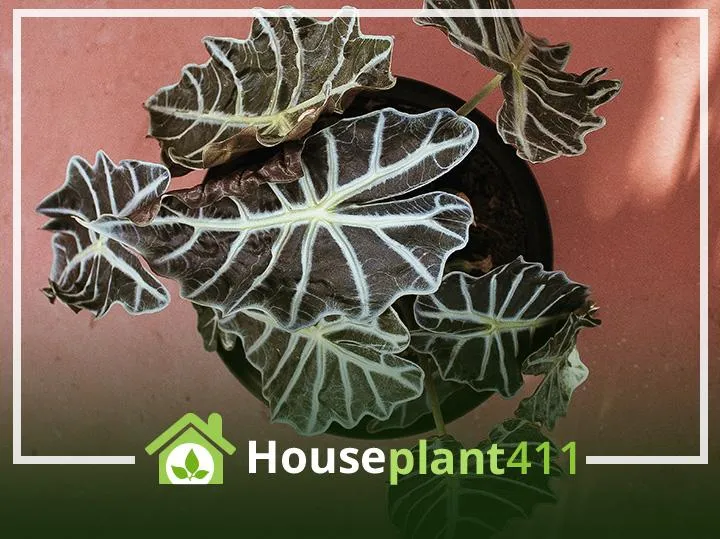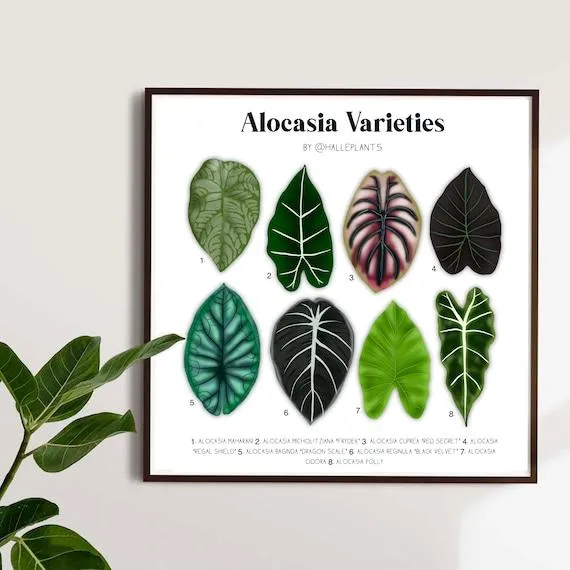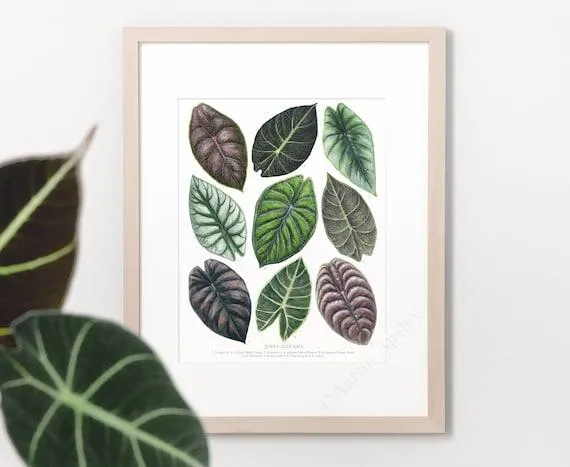An Overview of Popular Alocasia Velvet Varieties
The Alocasia genus consists of many beautiful tropical plants known for their unique velvety leaves. As an avid plant collector, I’ve had the pleasure of growing several Alocasia velvet varieties in my home. In this article, I’ll discuss the most common types and share insights into their care based on my experiences.
Alocasia ‘Polly’
Undoubtedly one of the most popular houseplants around, Alocasia ‘Polly’ has gorgeous deep green leaves with contrasting pale silver veins. From my experience, it thrives in medium to bright indirect light and likes to dry out slightly between waterings. I remember watering mine too frequently at first, which caused root rot. Now I wait until the soil is mostly dry and the leaves start to soften a bit.
Propagation is fairly easy – you can divide the corms or root the stems in water. I was able to get two new plants started from a single crown! Alocasia ‘Polly’ is quite rugged and will reward you with new growth for many years if treated well. Its size remains manageable, maxing out around 2-3 feet tall depending on conditions.
Alocasia ‘Amazonica’
With immense velvety leaves that can reach over 3 feet long, Alocasia ‘Amazonica’ truly lives up to its name. I find it to be a stunning specimen plant but it demands more care than others. It prefers high humidity around 50% or more. On one occasion, I left for a weekend trip after watering mine and came back to limp leaves – it had gotten too dry. Now I have a pebble tray under it to boost moisture levels.

This variety grows rapidly in the spring and summer. Be prepared to repot up a size annually as it will outgrow its container quickly. Reportedly it can grow several inches per week during active growth periods! Its sheer size also means it can be more prone to pests like spider mites. I give mine a thorough inspection every few weeks, catching any issues early. But the Amazonica’s magnificence makes any extra TLC worthwhile.
Other Popular Varieties
- Alocasia ‘Grey Dragon’ – Characterized by greyish-green leaves blotched with dark purple. It has a neat cupped shape.
- Alocasia ‘Portodora’ – Wide scalloped leaves of navy blue with vibrant splashes of lime green. Can grow as tall as 6 feet!
- Alocasia ‘Borneo Giant’ – Among the largest of all with leaves nearing 4 feet across. Humidity and drainage are crucial for this challenge to flourish.
- Alocasia ‘Black Velvet’ – Dark chocolatey leaves every bit as velvety as its name implies. Not as demanding as some others.
Pruning Your Alocasia
All Alocasias will benefit from periodic pruning to maintain a bushy habit and prevent legginess. I usually do this in spring after new growth emerges. You can remove any damaged, diseased or declining leaves. I’ll also cut back longer bare stems by about 1/3 their length. This encourages more compact growth from lower nodes.
Be sure not to over-prune, as the plant needs leaves to photosynthesize. I gently remove a few at a time over multiple prunings. From experience, abrupt severe pruning can send the plant into shock. Go slowly, giving it a chance to adapt between trimmings. Proper pruning is key for long-term health and attractive appearance of your Alocasia.
Common Pests and Problems
Many pests find Alocasia a tasty treat due to their soft leaf texture. The three main offenders in my experience are spider mites, scale and mealybugs. I usually catch mite infestations starting as a stipling on the leaves. A thorough spraying with insecticidal soap does the trick. Scale is a little harder to remove once established – I’ve had luck wiping leaves with isopropyl alcohol on a cotton ball.

Root rot from overwatering is always a risk too. I lost my first Alocasia this way as a new plant parent. Now I’m more careful about drainage and allowing the soil to dry out between drinks. Brown tips and edges can sometimes be a sign of underwatering as well. With some trial and error, you’ll learn each variety’s unique watering needs. Just don’t give up – these velvety beauties are usually very forgiving plants.
So in summary, I hope this overview helped provide answers about growing a variety of popular Alocasia velvet plants! Their exotic leaves make great accents indoors. With a bit of care tailored to their needs, you can enjoy these beauties for many years. Feel free to experiment and discover which types suit your conditions best. Let me know if you have any other questions!
Alocasia Velvet Varieties
| Name | Leaf Color | Care Level | Max Height |
|---|---|---|---|
| Alocasia ‘Velveteen’ | Dark green with black velvet | Moderate | 2-3 feet |
| Alocasia ‘Jade Dragon’ | Variegated green and white | Moderate | 2-3 feet |
| Alocasia ‘Black Velvet’ | Deep burgundy-black leaves | Easy | 2-4 feet |
| Alocasia ‘Portodora’ | Variegated green, cream and pink | Moderate | 2-3 feet |
| Alocasia ‘Regal Shields’ | Variegated white and green | Moderate | 3-5 feet |
FAQ
-
What are some popular types of alocasia velvet plants?
Basically, there are a few sorts of alocasia velvets that people like. Some big ones are:
- Alocasia ‘Velvet Moss’ – Known for its velvety green leaves with gray veining. Sort of lovely!
- Alocasia ‘Dark Velvet’ – As the name suggests, it’s leaves are very dark green. Almost black on the edges, like a mysterious plant.
- Alocasia ‘Amazonica’ – Giant leaves up to 2 feet long! But you need space for this beauty. It’s stunning whatever size though.
-
Do alocasia velvets grow from bulbs or rhizomes?
Alocasias increase by rhizomes rather than bulbs. Basically, a rhizome is an underground stem that sends out roots and shoot growth points along its length. Kind of like a horizontal runner you might see in grass. So new plants will form where the rhizome touches the soil. On the other hand, bulbs like tulips have tightly packed underground leaves.

-
How quickly do they grow?
The rate of growth for alocasia velvets can vary a lot depending on conditions. But generally speaking, they don’t grow super fast – maybe a new leaf every couple months. However, if grown in ideal conditions with plenty of warmth, humidity and fertilizer, some varieties might put on a new leaf each month. At the same time, they may sulk a bit if it’s too cold or dry. So you gotta find that happy medium!
-
What kind of care do alocasia velvets need?
Alocasias like conditions to be on the moist side. Their soil should never fully dry out. Nevertheless, they don’t want soggy wet feet either. A well-draining potting mix is key. They also dig high humidity. So consider a pebble tray or humidifier. In terms of light, they do best with bright, indirect sun. But is direct sun okay for an hour or two? You’ll have to experiment based on your growing conditions. On the other hand, they don’t want super low light that makes them leggy.
-
Are alocasia velvet plants poisonous?
You know, I was surprised to find out that alocasia plants contain calcium oxalate crystals in their leaves and stems. While this makes their skin feel velvety, it can also cause mouth irritation or even be toxic in large quantities. So I wouldn’t eat my plants! However, keeping them out of reach of small children and pets is always a good idea. The toxins are mostly present in unripe berries and sprouts, less so in mature plants. But better safe than sorry right?
-
What are some pests and diseases to watch out for?
The biggest pest for alocasia velvets seems to be spider mites. Those tiny eight-legged creeps love to party on the undersides of leaves and suck out the plant juices. You may see signs like yellow or stippling spots. A strong spray of water or neem oil can help blast them away. On the other hand, overwatering can cause root rot issues in the soil. And slugs have a taste for tender new growth. But with some TLC, alocasias can be remarkably pest- and disease-resistant houseplants overall.

-
How do you propagate alocasia velvets?
There are a few different ways to propagate these beauties. Possibly the easiest is dividing the rhizomes when repotting or when you see babies forming at the ends. But you can also try rooting stem or leaf cuttings in water or moist soil. Make sure to remove the lowest leaf and cut just below a node. Wonder if that will even work since alocasias are different than pothos? You never know until you try. Please share your experiences – it’ll help the rest of us learn too!
